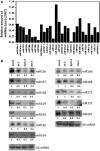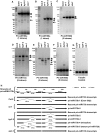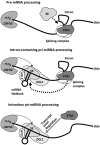STA1, an Arabidopsis pre-mRNA processing factor 6 homolog, is a new player involved in miRNA biogenesis
- PMID: 23268445
- PMCID: PMC3561960
- DOI: 10.1093/nar/gks1309
STA1, an Arabidopsis pre-mRNA processing factor 6 homolog, is a new player involved in miRNA biogenesis
Abstract
MicroRNAs (miRNAs) are small regulatory RNAs that have important regulatory roles in numerous developmental and metabolic processes in most eukaryotes. In Arabidopsis, DICER-LIKE1 (DCL1), HYPONASTIC LEAVES 1, SERRATE, HUA ENHANCER1 and HASTY are involved in processing of primary miRNAs (pri-miRNAs) to yield precursor miRNAs (pre-miRNAs) and eventually miRNAs. In addition to these components, mRNA cap-binding proteins, CBP80/ABA HYPERSENSITIVE1 and CBP20, also participate in miRNA biogenesis. Here, we show that STABILIZED1 (STA1), an Arabidopsis pre-mRNA processing factor 6 homolog, is also involved in the biogenesis of miRNAs. Similar to other miRNA biogenesis-defective mutants, sta1-1 accumulated significantly lower levels of mature miRNAs and concurrently higher levels of pri-miRNAs than wild type. The dramatic reductions of mature miRNAs were associated with the accumulation of their target gene transcripts and developmental defects. Furthermore, sta1-1 impaired splicing of intron containing pri-miRNAs and decreased transcript levels of DCL1. These results suggest that STA1 is involved in miRNA biogenesis directly by functioning in pri-miRNA splicing and indirectly by modulating the DCL1 transcript level.
Figures







Similar articles
-
Recent advances in the regulation of plant miRNA biogenesis.RNA Biol. 2021 Dec;18(12):2087-2096. doi: 10.1080/15476286.2021.1899491. Epub 2021 Mar 17. RNA Biol. 2021. PMID: 33666136 Free PMC article. Review.
-
Dual roles of the nuclear cap-binding complex and SERRATE in pre-mRNA splicing and microRNA processing in Arabidopsis thaliana.Proc Natl Acad Sci U S A. 2008 Jun 24;105(25):8795-800. doi: 10.1073/pnas.0802493105. Epub 2008 Jun 12. Proc Natl Acad Sci U S A. 2008. PMID: 18550839 Free PMC article.
-
NOT2 proteins promote polymerase II-dependent transcription and interact with multiple MicroRNA biogenesis factors in Arabidopsis.Plant Cell. 2013 Feb;25(2):715-27. doi: 10.1105/tpc.112.105882. Epub 2013 Feb 19. Plant Cell. 2013. PMID: 23424246 Free PMC article.
-
Serrate-Associated Protein 1, a splicing-related protein, promotes miRNA biogenesis in Arabidopsis.New Phytol. 2021 Dec;232(5):1959-1973. doi: 10.1111/nph.17691. Epub 2021 Sep 16. New Phytol. 2021. PMID: 34449907 Free PMC article.
-
New insights into pri-miRNA processing and accumulation in plants.Wiley Interdiscip Rev RNA. 2015 Sep-Oct;6(5):533-45. doi: 10.1002/wrna.1292. Epub 2015 Jun 29. Wiley Interdiscip Rev RNA. 2015. PMID: 26119101 Review.
Cited by
-
Marking RNA: m6A writers, readers, and functions in Arabidopsis.J Mol Cell Biol. 2019 Oct 25;11(10):899-910. doi: 10.1093/jmcb/mjz085. J Mol Cell Biol. 2019. PMID: 31336387 Free PMC article.
-
Redox status of the plant cell determines epigenetic modifications under abiotic stress conditions and during developmental processes.J Adv Res. 2022 Dec;42:99-116. doi: 10.1016/j.jare.2022.04.007. Epub 2022 Apr 28. J Adv Res. 2022. PMID: 35690579 Free PMC article. Review.
-
Small RNAs Participate in Plant-Virus Interaction and Their Application in Plant Viral Defense.Int J Mol Sci. 2022 Jan 8;23(2):696. doi: 10.3390/ijms23020696. Int J Mol Sci. 2022. PMID: 35054880 Free PMC article. Review.
-
Identification and Functional Analysis of microRNAs Involved in the Anther Development in Cotton Genic Male Sterile Line Yu98-8A.Int J Mol Sci. 2016 Oct 7;17(10):1677. doi: 10.3390/ijms17101677. Int J Mol Sci. 2016. PMID: 27739413 Free PMC article.
-
Recent advances in the regulation of plant miRNA biogenesis.RNA Biol. 2021 Dec;18(12):2087-2096. doi: 10.1080/15476286.2021.1899491. Epub 2021 Mar 17. RNA Biol. 2021. PMID: 33666136 Free PMC article. Review.
References
Publication types
MeSH terms
Substances
Grants and funding
LinkOut - more resources
Full Text Sources
Other Literature Sources
Molecular Biology Databases
Miscellaneous

